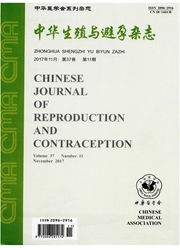

 中文摘要:
中文摘要:
目的:探讨血清学筛查唐氏综合征高风险与不良妊娠结局发生的关系。方法:以血清学筛查且唐氏综合征风险值≥1/270的孕妇列为高危组,唐氏综合征风险值〈1/270的孕妇列为低危组,对高危组、低危组的胎儿染色体病、系统超声检查结果、妊娠并发症、新生儿情况等进行分析。结果:807例高危组患者21-三体、超声结构畸形、自然流产、死胎、胎盘早剥、新生儿窒息发生率分别为1.36%(11/807)、4.96%(40/807)、4.09%(33/807)、2.11%(17/807)、1.12%(9/807)、1.36%(11/807),均高于低危组(n=1 614)的0.06%(1/1 614)、1.80%(29/1 614)、0.12%(2/1 614)、0.31%(5/1 614)、0.31%(5/1 614)、0.25%(4/1 614),差异均有统计学意义(P〈0.05)。结论:血清学筛查唐氏综合征高风险病例,不良妊娠结局发生率高。
 英文摘要:
英文摘要:
Objective: To investigate the relationship between high-risk serum screening for Down's syndrome(DS) and the incidence of adverse pregnancy outcomes. Methods: Pregnant women who underwent serum screening for DS were investigated. Eight hundred and seven cases whose value of serum screening for DS was ≥ 1/270 were identified as high-risk group, 1 614 cases whose value of serum screening for DS was 〈 1/270 were identified as low-risk group. Fetal chromosomal diseases, genetic sonography, pregnancy complications, and neonatal outcomes of pregnant women were compared between high-risk group and low-risk group. Results: In high-risk group, the incidence of DS, sonographically structural abnormality, abortion, fetal death, placental abruption and neonatal asphyxia were 1.36%(11/807), 4.96%(40/807), 4.09%(33/807), 2.11%(17/807), 1.12%(9/807) and 1.36%(11/807), respectively, which were all higher than those in low-risk group,they were 0.06%(1/1 614), 1.80%(29/1 614), 0.12%(2/1 614), 0.31%(5/1 614), 0.31%(5/1 614) and 0.25%(4/1 614), respectively(P〈0.05). Conclusion: Among the cases with high-risk serum screening for DS, the incidence of adverse pregnancy outcomes was high.
 同期刊论文项目
同期刊论文项目
 同项目期刊论文
同项目期刊论文
 期刊信息
期刊信息
